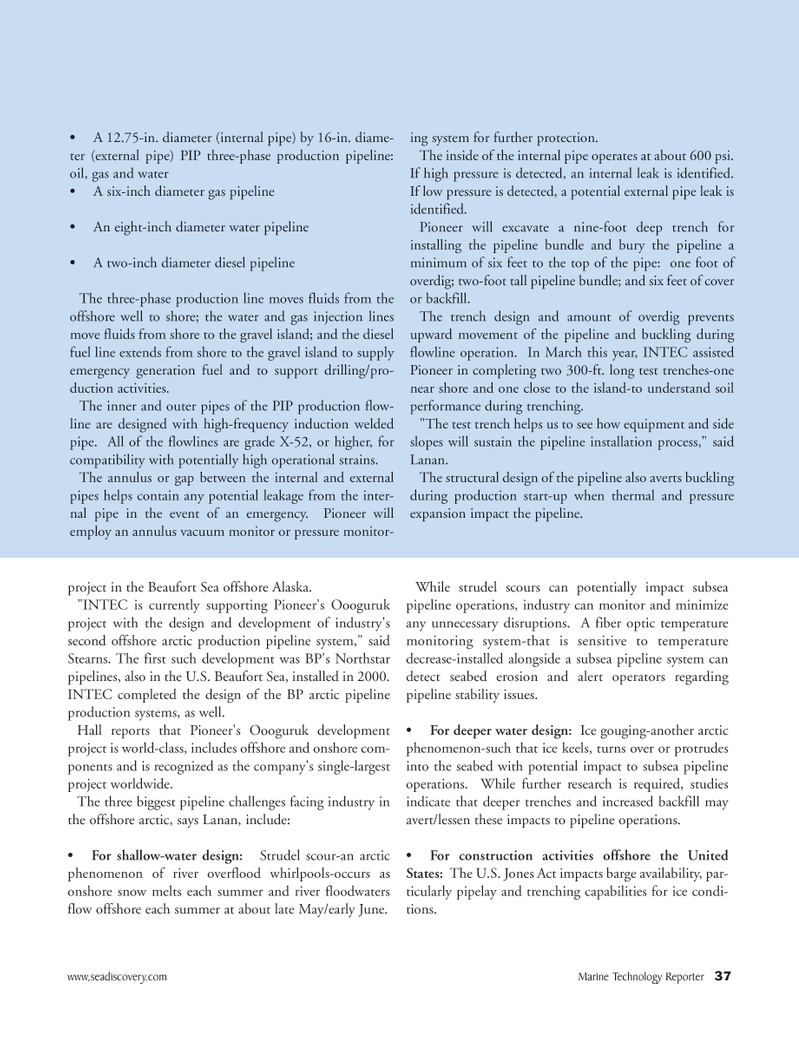
Page 37: of Marine Technology Magazine (July 2006)
Underwater Defense: Port & Harbor Security
Read this page in Pdf, Flash or Html5 edition of July 2006 Marine Technology Magazine
www,seadiscovery.com Marine Technology Reporter 37 • A 12.75-in. diameter (internal pipe) by 16-in. diame- ter (external pipe) PIP three-phase production pipeline: oil, gas and water A six-inch diameter gas pipeline An eight-inch diameter water pipeline A two-inch diameter diesel pipeline
The three-phase production line moves fluids from the offshore well to shore; the water and gas injection lines move fluids from shore to the gravel island; and the diesel fuel line extends from shore to the gravel island to supply emergency generation fuel and to support drilling/pro- duction activities.
The inner and outer pipes of the PIP production flow- line are designed with high-frequency induction welded pipe. All of the flowlines are grade X-52, or higher, for compatibility with potentially high operational strains.
The annulus or gap between the internal and external pipes helps contain any potential leakage from the inter- nal pipe in the event of an emergency. Pioneer will employ an annulus vacuum monitor or pressure monitor- ing system for further protection.
The inside of the internal pipe operates at about 600 psi.
If high pressure is detected, an internal leak is identified.
If low pressure is detected, a potential external pipe leak is identified.
Pioneer will excavate a nine-foot deep trench for installing the pipeline bundle and bury the pipeline a minimum of six feet to the top of the pipe: one foot of overdig; two-foot tall pipeline bundle; and six feet of cover or backfill.
The trench design and amount of overdig prevents upward movement of the pipeline and buckling during flowline operation. In March this year, INTEC assisted
Pioneer in completing two 300-ft. long test trenches-one near shore and one close to the island-to understand soil performance during trenching. "The test trench helps us to see how equipment and side slopes will sustain the pipeline installation process," said
Lanan.
The structural design of the pipeline also averts buckling during production start-up when thermal and pressure expansion impact the pipeline. project in the Beaufort Sea offshore Alaska. "INTEC is currently supporting Pioneer's Oooguruk project with the design and development of industry's second offshore arctic production pipeline system," said
Stearns. The first such development was BP's Northstar pipelines, also in the U.S. Beaufort Sea, installed in 2000.
INTEC completed the design of the BP arctic pipeline production systems, as well.
Hall reports that Pioneer's Oooguruk development project is world-class, includes offshore and onshore com- ponents and is recognized as the company's single-largest project worldwide.
The three biggest pipeline challenges facing industry in the offshore arctic, says Lanan, include: For shallow-water design: Strudel scour-an arctic phenomenon of river overflood whirlpools-occurs as onshore snow melts each summer and river floodwaters flow offshore each summer at about late May/early June.
While strudel scours can potentially impact subsea pipeline operations, industry can monitor and minimize any unnecessary disruptions. A fiber optic temperature monitoring system-that is sensitive to temperature decrease-installed alongside a subsea pipeline system can detect seabed erosion and alert operators regarding pipeline stability issues. For deeper water design: Ice gouging-another arctic phenomenon-such that ice keels, turns over or protrudes into the seabed with potential impact to subsea pipeline operations. While further research is required, studies indicate that deeper trenches and increased backfill may avert/lessen these impacts to pipeline operations. For construction activities offshore the United
States: The U.S. Jones Act impacts barge availability, par- ticularly pipelay and trenching capabilities for ice condi- tions.
MTR#6 (33-48).qxd 7/11/2006 9:09 AM Page 37

 36
36

 38
38
